YAMAHA SUV 1200 2001 Owners Manual
Manufacturer: YAMAHA, Model Year: 2001, Model line: SUV 1200, Model: YAMAHA SUV 1200 2001Pages: 135, PDF Size: 21.67 MB
Page 101 of 135
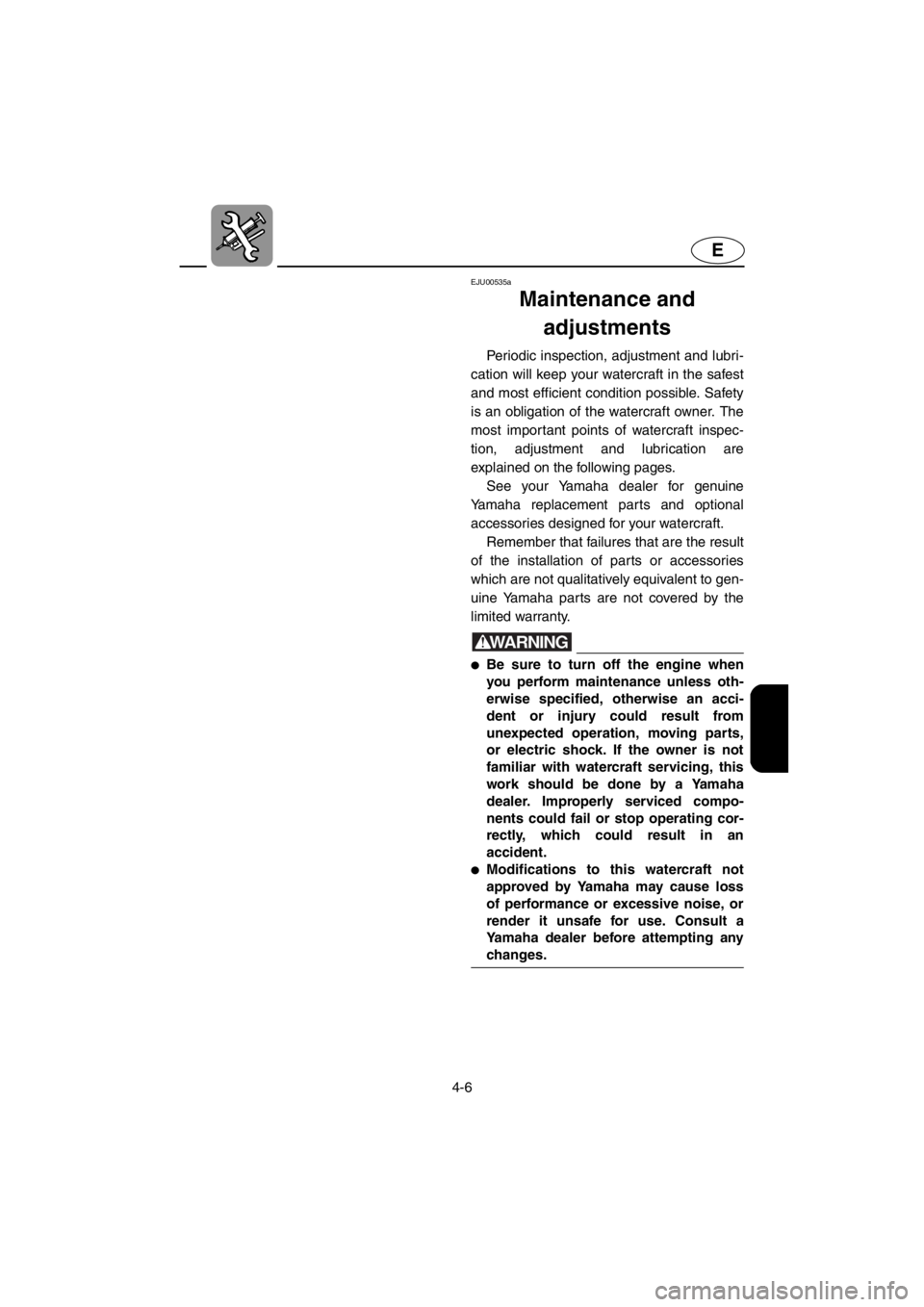
4-6
E
EJU00535a
Maintenance and
adjustments
Periodic inspection, adjustment and lubri-
cation will keep your watercraft in the safest
and most efficient condition possible. Safety
is an obligation of the watercraft owner. The
most important points of watercraft inspec-
tion, adjustment and lubrication are
explained on the following pages.
See your Yamaha dealer for genuine
Yamaha replacement parts and optional
accessories designed for your watercraft.
Remember that failures that are the result
of the installation of parts or accessories
which are not qualitatively equivalent to gen-
uine Yamaha parts are not covered by the
limited warranty.
WARNING
●Be sure to turn off the engine when
you perform maintenance unless oth-
erwise specified, otherwise an acci-
dent or injury could result from
unexpected operation, moving parts,
or electric shock. If the owner is not
familiar with watercraft servicing, this
work should be done by a Yamaha
dealer. Improperly serviced compo-
nents could fail or stop operating cor-
rectly, which could result in an
accident.
●Modifications to this watercraft not
approved by Yamaha may cause loss
of performance or excessive noise, or
render it unsafe for use. Consult a
Yamaha dealer before attempting any
changes.
E_GU5-71-4.fm Page 6 Thursday, July 13, 2000 7:54 PM
Page 102 of 135
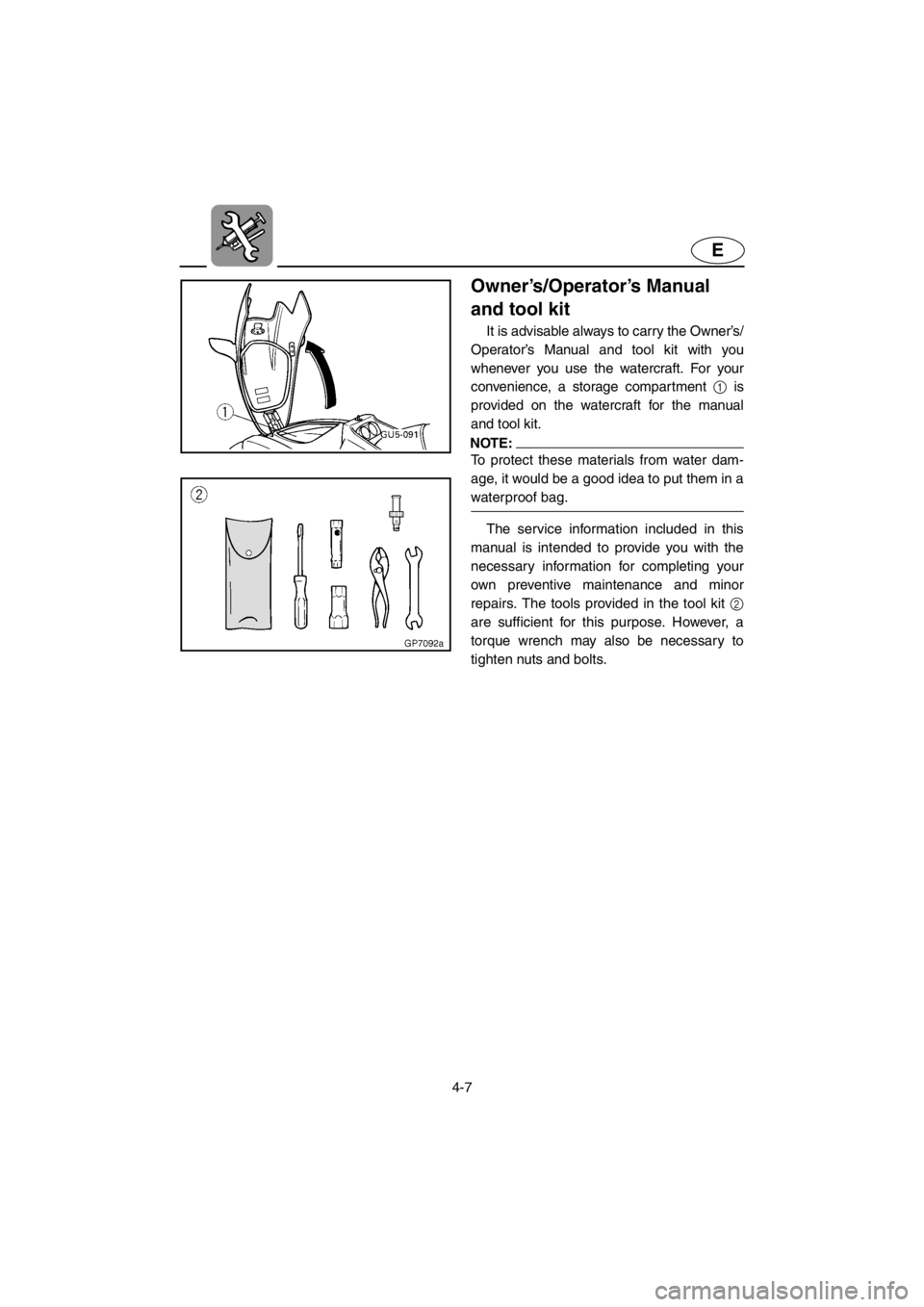
4-7
E
Owner’s/Operator’s Manual
and tool kit
It is advisable always to carry the Owner’s/
Operator’s Manual and tool kit with you
whenever you use the watercraft. For your
convenience, a storage compartment 1 is
provided on the watercraft for the manual
and tool kit.
NOTE:
To protect these materials from water dam-
age, it would be a good idea to put them in a
waterproof bag.
The service information included in this
manual is intended to provide you with the
necessary information for completing your
own preventive maintenance and minor
repairs. The tools provided in the tool kit 2
are sufficient for this purpose. However, a
torque wrench may also be necessary to
tighten nuts and bolts.
E_GU5-71-4.fm Page 7 Thursday, July 13, 2000 7:54 PM
Page 103 of 135

4-8
E
EJU00536
Periodic maintenance chart
The following chart gives general guidelines for periodic maintenance. However, depend-
ing on your operating conditions maintenance may need to be performed more frequently.
(
●) This mark indicates maintenance that you may do yourself.
(
❍) This mark indicates work to be done by a Yamaha dealer.
*1: Grease capacity: 33.0–35.0 cm3 (1.11–1.18 oz)
*2: Grease capacity: 6.0–8.0 cm3 (0.20–0.27 oz)
*3: Grease capacity: 8.0 cm3 (0.27 oz)
*4: Grease capacity: 2.0 cm3 (0.07 oz)
MAINTENANCE INTERVAL INITIALTHEREAFTER
EVERYPA G E
10
hours50
hours100
hours100
hours200
hours
ITEM
3
months6
months6
months12
months
Spark plug Inspect, clean, adjust●●●●
4-14
Lubrication points Lubricate●●
4-15
Intermediate housing Lubricate❍
*1●
*2●
*2 4-18
Starter motor idle gear Lubricate❍
*3●
*4●
*4 4-18
Fuel system Inspect❍❍
4-9
Fuel filter Check, replace❍❍
4-10
Fuel tank Clean❍
4-10
Oil injection system Inspect, clean❍❍
—
Carburetor setting Inspect, adjust❍❍❍
4-21
Trolling speed Adjust●●
4-21
Carburetor throttle shaft Inspect❍❍
—
Cooling water passages Flush
●
(after
ever y
use)4-1
Bilge strainer Clean●●●
—
Impeller Inspect●●●
5-4
Steering cable Inspect●●
5-4
Steering master Inspect❍❍❍
—
QSTS mechanism Inspect●●
4-13
Shift cable and mechanism Inspect, adjust●●
4-17
Throttle cable Inspect, adjust●●
4-16
Choke cable Inspect, adjust●●
4-18
Stern drain plugs Inspect, replace●
3-7
Battery Inspect
●(inspect
fluid level
before
ever y
use)
4-19
Rubber coupling Inspect❍
—
Nuts and bolts Tighten❍❍❍
—
E_GU5-71-4.fm Page 8 Thursday, July 13, 2000 7:54 PM
Page 104 of 135
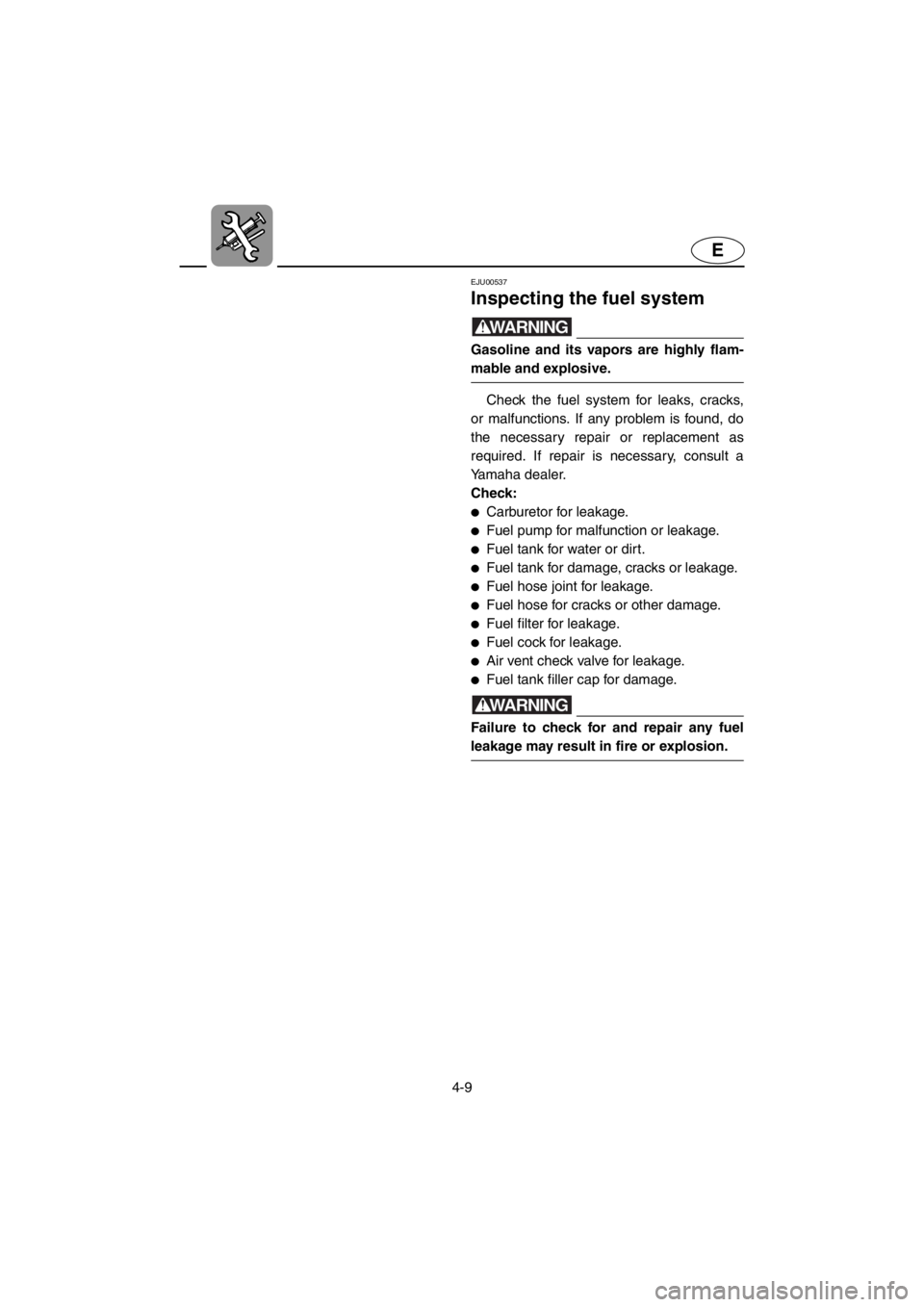
4-9
E
EJU00537
Inspecting the fuel system
WARNING
Gasoline and its vapors are highly flam-
mable and explosive.
Check the fuel system for leaks, cracks,
or malfunctions. If any problem is found, do
the necessary repair or replacement as
required. If repair is necessary, consult a
Yamaha dealer.
Check:
●Carburetor for leakage.
●Fuel pump for malfunction or leakage.
●Fuel tank for water or dirt.
●Fuel tank for damage, cracks or leakage.
●Fuel hose joint for leakage.
●Fuel hose for cracks or other damage.
●Fuel filter for leakage.
●Fuel cock for leakage.
●Air vent check valve for leakage.
●Fuel tank filler cap for damage.
WARNING
Failure to check for and repair any fuel
leakage may result in fire or explosion.
E_GU5-71-4.fm Page 9 Thursday, July 13, 2000 7:54 PM
Page 105 of 135
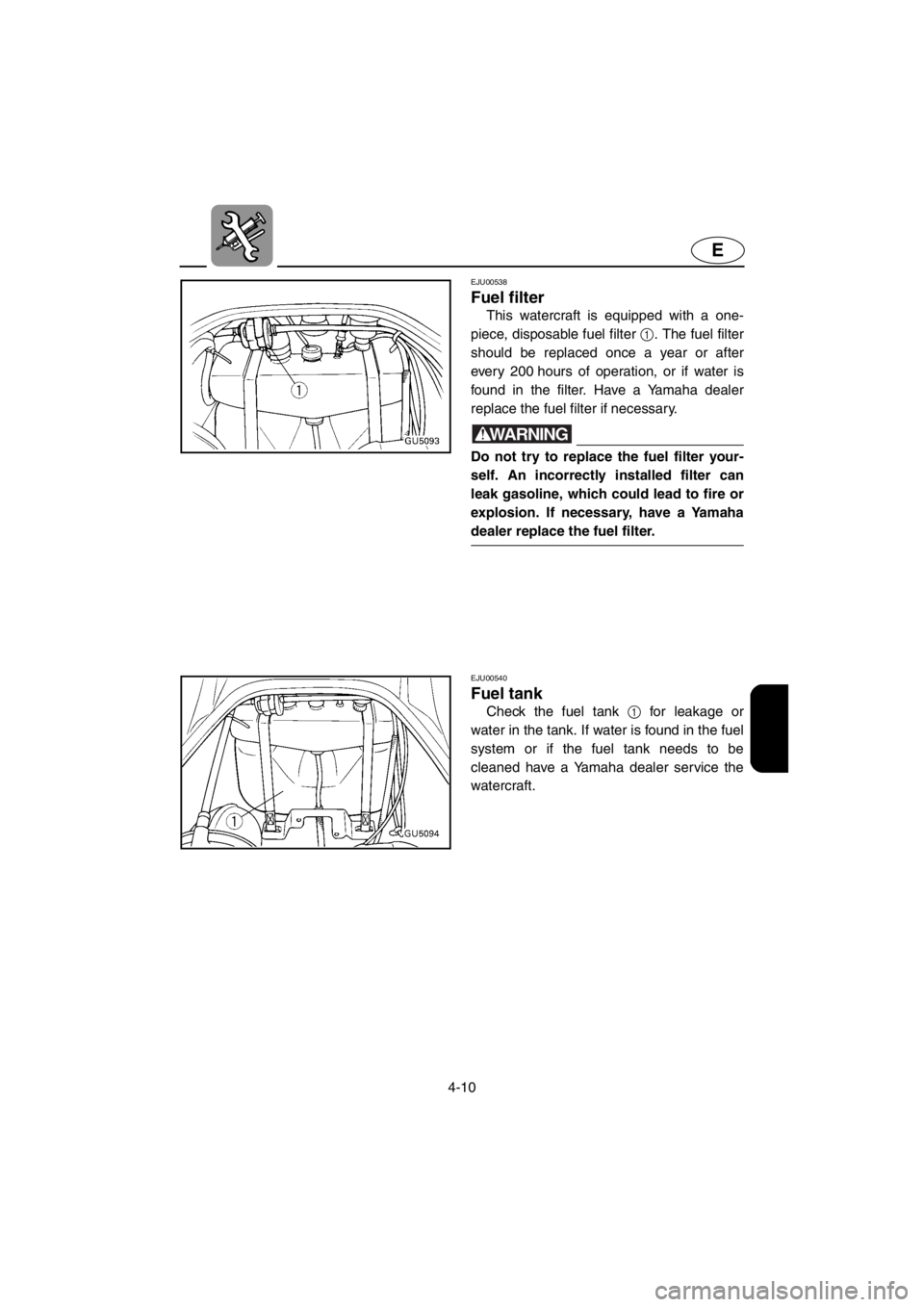
4-10
E
EJU00538
Fuel filter
This watercraft is equipped with a one-
piece, disposable fuel filter 1. The fuel filter
should be replaced once a year or after
every 200 hours of operation, or if water is
found in the filter. Have a Yamaha dealer
replace the fuel filter if necessary.
WARNING
Do not try to replace the fuel filter your-
self. An incorrectly installed filter can
leak gasoline, which could lead to fire or
explosion. If necessary, have a Yamaha
dealer replace the fuel filter.
EJU00540
Fuel tank
Check the fuel tank 1 for leakage or
water in the tank. If water is found in the fuel
system or if the fuel tank needs to be
cleaned have a Yamaha dealer service the
watercraft.
E_GU5-71-4.fm Page 10 Thursday, July 13, 2000 7:54 PM
Page 106 of 135
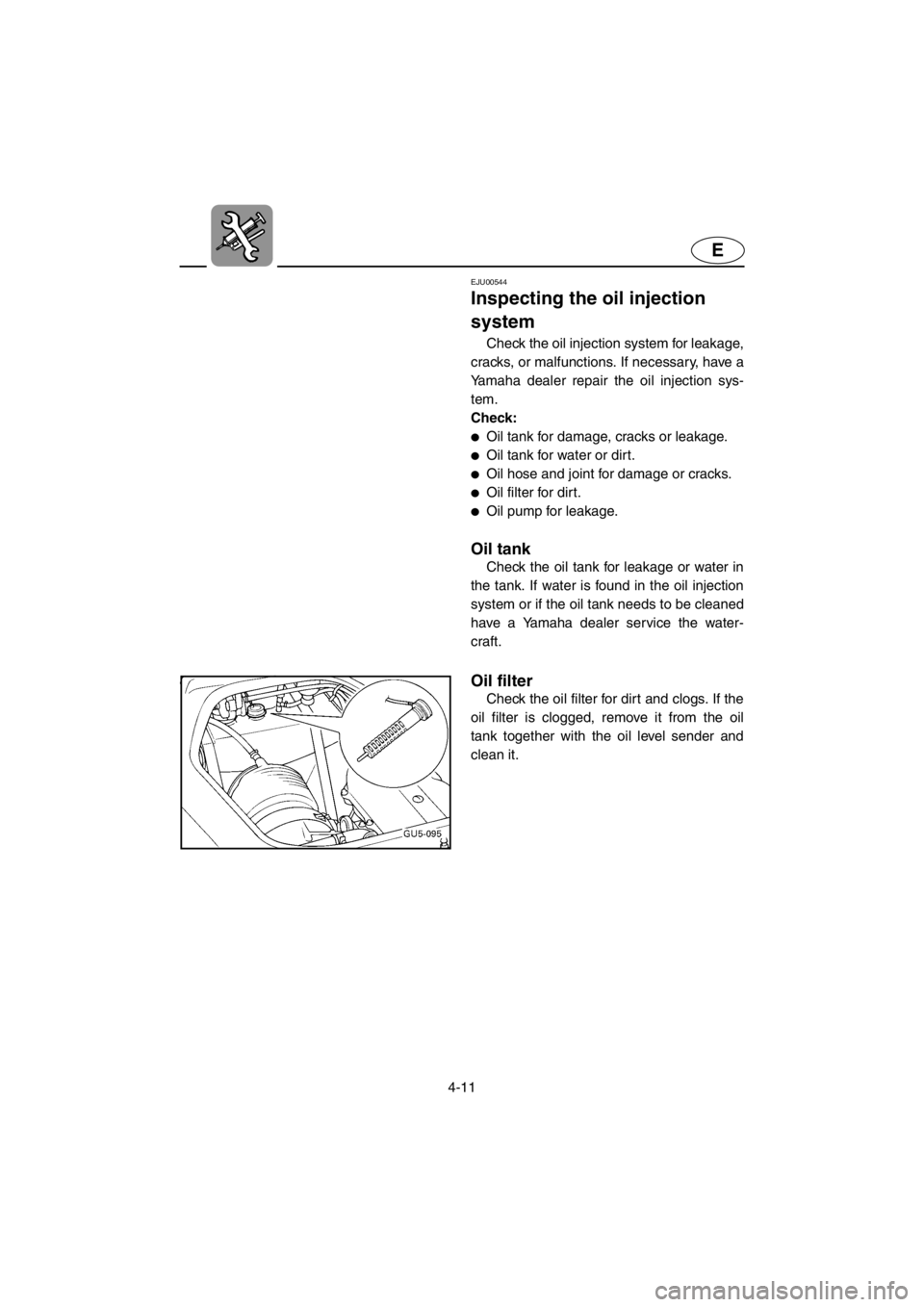
4-11
E
EJU00544
Inspecting the oil injection
system
Check the oil injection system for leakage,
cracks, or malfunctions. If necessary, have a
Yamaha dealer repair the oil injection sys-
tem.
Check:
●Oil tank for damage, cracks or leakage.
●Oil tank for water or dirt.
●Oil hose and joint for damage or cracks.
●Oil filter for dirt.
●Oil pump for leakage.
Oil tank
Check the oil tank for leakage or water in
the tank. If water is found in the oil injection
system or if the oil tank needs to be cleaned
have a Yamaha dealer service the water-
craft.
Oil filter
Check the oil filter for dirt and clogs. If the
oil filter is clogged, remove it from the oil
tank together with the oil level sender and
clean it.
E_GU5-71-4.fm Page 11 Thursday, July 13, 2000 7:54 PM
Page 107 of 135
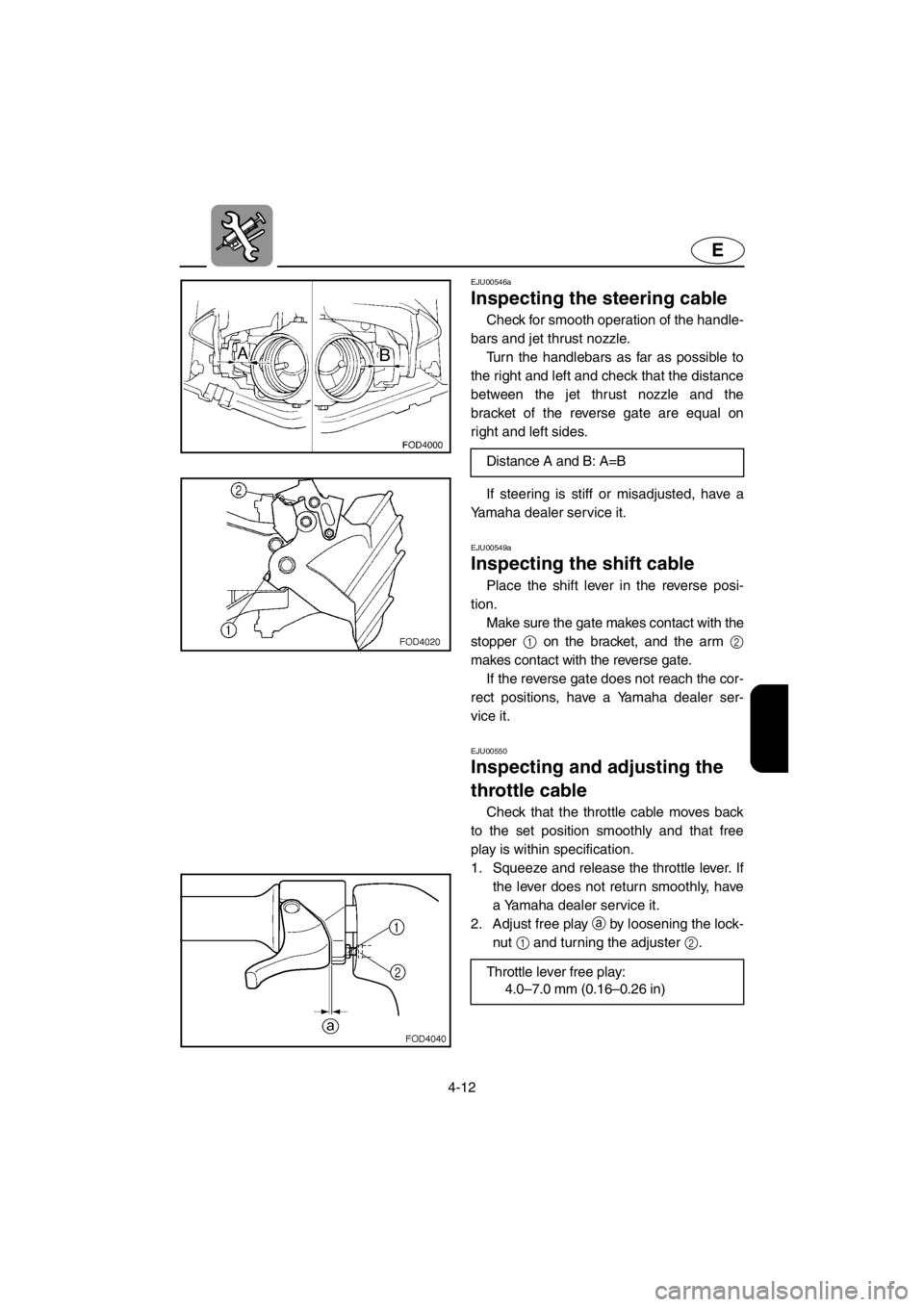
4-12
E
EJU00546a
Inspecting the steering cable
Check for smooth operation of the handle-
bars and jet thrust nozzle.
Turn the handlebars as far as possible to
the right and left and check that the distance
between the jet thrust nozzle and the
bracket of the reverse gate are equal on
right and left sides.
If steering is stiff or misadjusted, have a
Yamaha dealer service it.
EJU00549a
Inspecting the shift cable
Place the shift lever in the reverse posi-
tion.
Make sure the gate makes contact with the
stopper 1 on the bracket, and the arm 2
makes contact with the reverse gate.
If the reverse gate does not reach the cor-
rect positions, have a Yamaha dealer ser-
vice it.
EJU00550
Inspecting and adjusting the
throttle cable
Check that the throttle cable moves back
to the set position smoothly and that free
play is within specification.
1. Squeeze and release the throttle lever. If
the lever does not return smoothly, have
a Yamaha dealer service it.
2. Adjust free play a by loosening the lock-
nut 1 and turning the adjuster 2. Distance A and B: A=B
Throttle lever free play:
4.0–7.0 mm (0.16–0.26 in)
E_GU5-71-4.fm Page 12 Thursday, July 13, 2000 7:54 PM
Page 108 of 135
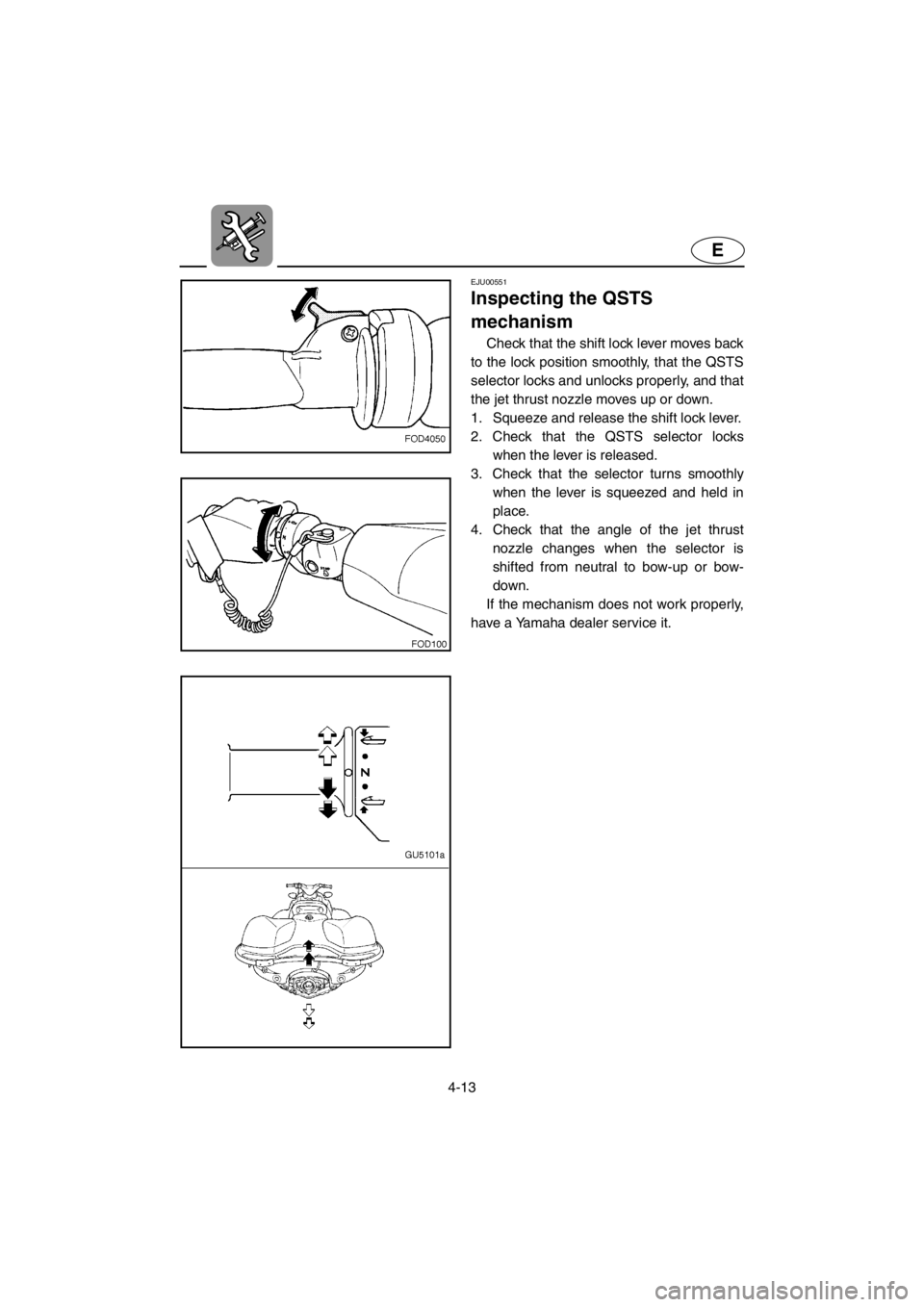
4-13
E
EJU00551
Inspecting the QSTS
mechanism
Check that the shift lock lever moves back
to the lock position smoothly, that the QSTS
selector locks and unlocks properly, and that
the jet thrust nozzle moves up or down.
1. Squeeze and release the shift lock lever.
2. Check that the QSTS selector locks
when the lever is released.
3. Check that the selector turns smoothly
when the lever is squeezed and held in
place.
4. Check that the angle of the jet thrust
nozzle changes when the selector is
shifted from neutral to bow-up or bow-
down.
If the mechanism does not work properly,
have a Yamaha dealer service it.
E_GU5-71-4.fm Page 13 Thursday, July 13, 2000 7:54 PM
Page 109 of 135
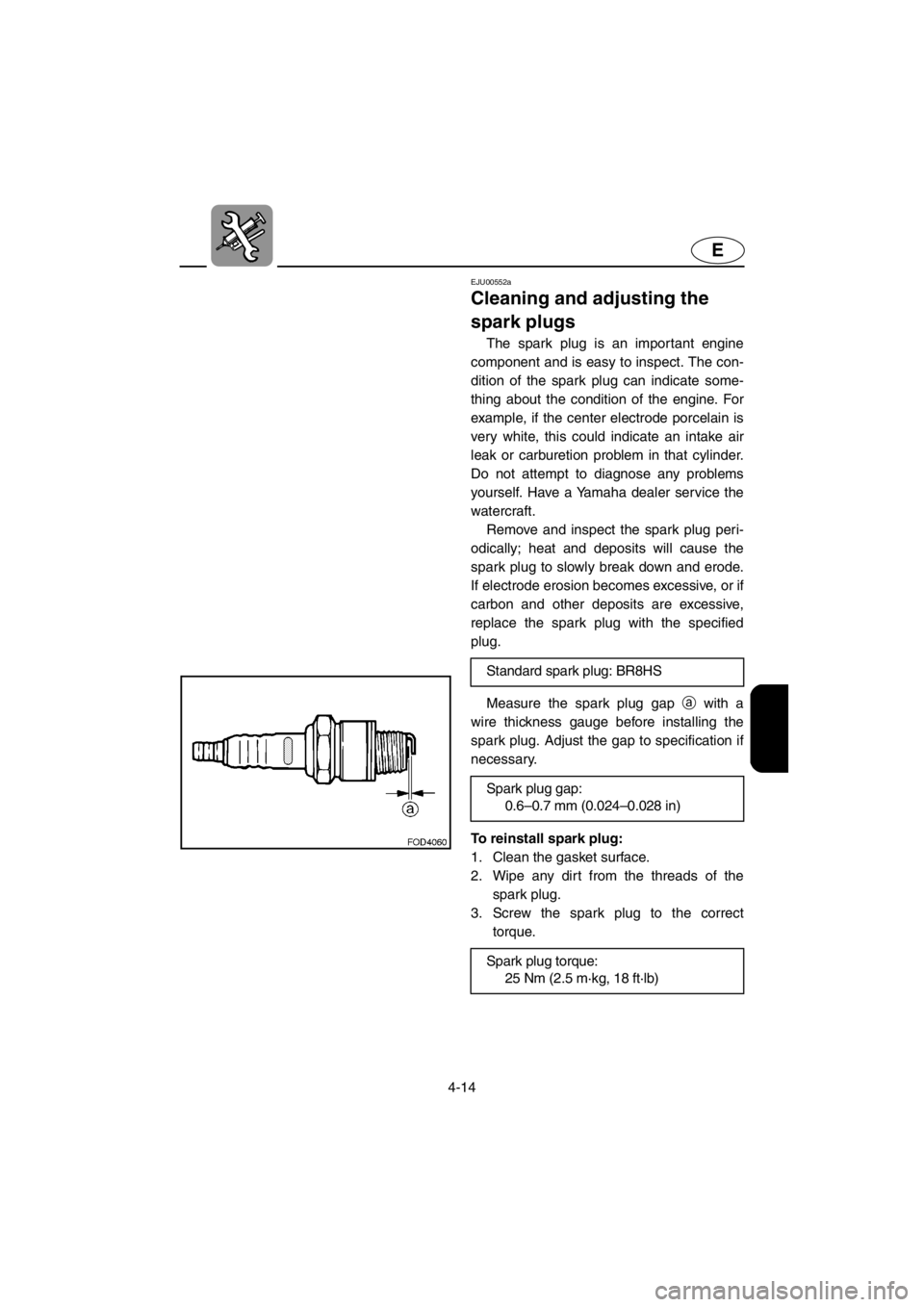
4-14
E
EJU00552a
Cleaning and adjusting the
spark plugs
The spark plug is an important engine
component and is easy to inspect. The con-
dition of the spark plug can indicate some-
thing about the condition of the engine. For
example, if the center electrode porcelain is
very white, this could indicate an intake air
leak or carburetion problem in that cylinder.
Do not attempt to diagnose any problems
yourself. Have a Yamaha dealer service the
watercraft.
Remove and inspect the spark plug peri-
odically; heat and deposits will cause the
spark plug to slowly break down and erode.
If electrode erosion becomes excessive, or if
carbon and other deposits are excessive,
replace the spark plug with the specified
plug.
Measure the spark plug gap a with a
wire thickness gauge before installing the
spark plug. Adjust the gap to specification if
necessary.
To reinstall spark plug:
1. Clean the gasket surface.
2. Wipe any dirt from the threads of the
spark plug.
3. Screw the spark plug to the correct
torque. Standard spark plug: BR8HS
Spark plug gap:
0.6–0.7 mm (0.024–0.028 in)
Spark plug torque:
25 Nm (2.5 m·kg, 18 ft·lb)
E_GU5-71-4.fm Page 14 Thursday, July 13, 2000 7:54 PM
Page 110 of 135
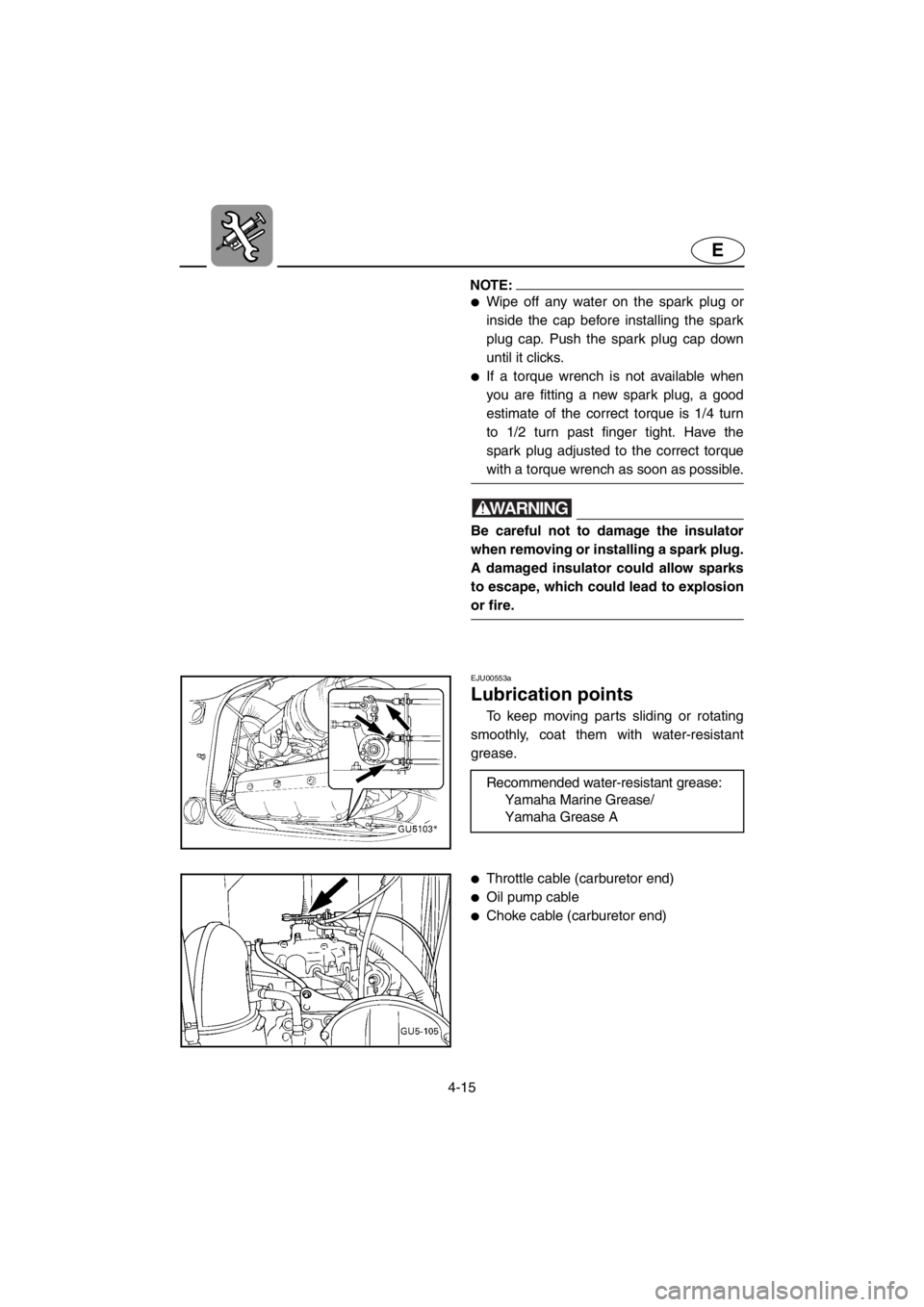
4-15
E
NOTE:
●Wipe off any water on the spark plug or
inside the cap before installing the spark
plug cap. Push the spark plug cap down
until it clicks.
●If a torque wrench is not available when
you are fitting a new spark plug, a good
estimate of the correct torque is 1/4 turn
to 1/2 turn past finger tight. Have the
spark plug adjusted to the correct torque
with a torque wrench as soon as possible.
WARNING
Be careful not to damage the insulator
when removing or installing a spark plug.
A damaged insulator could allow sparks
to escape, which could lead to explosion
or fire.
EJU00553a
Lubrication points
To keep moving parts sliding or rotating
smoothly, coat them with water-resistant
grease.
Recommended water-resistant grease:
Yamaha Marine Grease/
Yamaha Grease A
●Throttle cable (carburetor end)
●Oil pump cable
●Choke cable (carburetor end)
E_GU5-71-4.fm Page 15 Thursday, July 13, 2000 7:54 PM